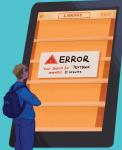There are many things to like about attending a university during the 21st century. Ask someone older, and they may share a horror story or two of lugging textbooks for miles, uphill both ways.
But even today, Bruins don’t have an easy time getting ahold of textbooks, with long lines in the Ackerman Student Union bookstore and per-quarter price tags. Textbooks take up money and time in terms of hunting for used book deals or waiting in lines.
These issues are only getting worse. According to a 2014 report by The Economist, textbook prices are only getting higher, at three times the rate of inflation since 1970. Class sizes are also climbing, with an increase of enrolled undergraduates at UCLA of more than 4,000 students in the last eight years. The demand for textbooks will likely stay high, and physical distribution of textbooks will likely remain impacted.
In other words, acquiring textbooks will only get more difficult.
Luckily, you won’t have to fish your grandpa’s old textbook out of the attic. The university has an option that could ease students’ cost and accessibility woes: digital textbooks.
Digital textbooks are easier to distribute, eliminate costs associated with printing and make the difficulty of handling physical books a thing of the past. It’s time UCLA considered a system to either lend or subsidize digital textbooks for students.
The payouts of going digital are significant.
In addition to better addressing general accessibility problems, digital textbooks have the potential to solve problems students with disabilities face. Educational material can be displayed and interacted with with greater flexibility than on paper.
That’s an important consideration, given students with disabilities already have access to accommodations for computer use, and compatible books could make life easier for them. These technologies include screen reader software and the option to magnify text, which can make it easier for those with vision impairments to access class content. Even eye-tracking systems have been developed, which remove the need to physically flip pages for those unable to.
There are a number of ways UCLA could go digital. Publishers, who set many of the textbook prices, may actually provide one answer. Cengage, a major publisher, recently made all of its material available for a yearly subscription. The university already provides students access to HBO Go, a media streaming subscription service, and has provided access to lynda.com, an online learning platform, in prior years. A similar system for paying for, if not subsidizing, digital textbook subscriptions could reduce the financial and time strain on students and UCLA’s bookstore.
Commercial options also exist for helping libraries lend digital books. Overdrive, one such company, is reportedly in a partnership with over 30,000 libraries. The company provides the infrastructure necessary for these institutions to lend books digitally. UCLA should consider entering such a partnership. The service provides support for many platforms, and contains accessibility features for students with disabilities. Though this specific service does not specialize in textbooks, UCLA, a major public university, could take the lead in forming such a partnership.
Open education resources are a part of another movement UCLA can join. These are educational materials that aim to be both free to use or modify, while still maintaining high quality. Because open educational resources are free, and largely available digitally, students have easier access to them.
Institutions, such as Rice University and the University of Minnesota, already contribute to open libraries, which largely feature digital resources. Nonprofit organizations, such as the William and Flora Hewlett Foundation, provide funding via grants to implement these open resource systems. UCLA should promote these materials to professors and work towards contributing their own.
Of course, UCLA’s Center for Accessible Education already makes certain accommodations available, but these can take time. A conversion to Braille, for example, can have expected times of up to eight weeks – nearly the entire quarter. Promoting digital textbooks, and making them normalized and easily available, could reduce these extra steps to simply checking the right setting.
A potential detriment of such a system would likely be the loss of the ability to resell used books. Reselling books is a easy way for students to save money, and many publishers implement a digital rights management policy that prevents the sharing or transfer of books. However, open resources, or even sufficiently subsidized books, would marginalize this cost. The loss of resale only requires that UCLA commit to the idea of digital books, and not settle for a half-measure.
It is 2018 – digital books are already a prevalent and widely available technology. Though the textbook market has its own complications, UCLA should strive to bring that convenience, cost effectiveness and accessibility to its students.
Digital textbooks can solve issues with distribution and student budgets. Even if the effort is long-term, perhaps the students of the future won’t look back with horror at our own paper-bound dilemma.
